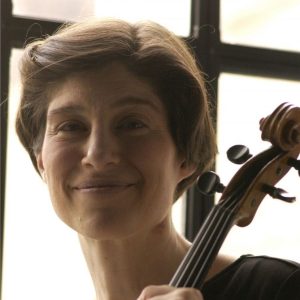
Maintaining Structure and Purpose in Your Day During COVID
Kim Kashkashian
Reprinted with permission from The Violin Channel.
Violist Kim Kashkashian shares her thoughts on how she feels students can best maintain structure and purpose in their day during this pandemic.
“Thoughts and musings on performing artists living at home …
Where do we fit in as artists? Where do we fit in as citizens? How can we lead a productive artistic life?
Our primary impulse- indeed, our primary need as artists is to create and share pure truth. We are all, in that sense, part of the healing profession. It is humbling and inspiring to recognize the potency and power of the visceral in our art. The power of resonance, vibration, sound waves in space and the organic feedback of an audience are unique and seemingly irreplaceable. But, we must look for a new integration of art and communication. Perhaps, resonance and vibration are replaced by imagination and fantasy. Perhaps, sharing sounds in a physical space will feel even more precious to us after exercising our fantasy. Perhaps, one or many of you will create new forms of sharing and communicating.
As we work towards new forms of creation and communication, we must continue to believe in the ultimate power of the organic. And we must believe in our work which is the power of combining art and craft to execute your intentions.
Under normal conditions, a performing musician:
1) Tells the news
2) Tells the truth as they see it
3) Acts as a conduit between composer and listener
4) Moves the hearts minds and spirits of their listeners
All four goals are possible to sense and implement at home.
The practicalities
We must forge a path by using our intention, not our desire, as our motivation. To implement my “prescription for survival at home” you will need a very long piece of paper to hang on the wall!
1) Long-term goals:
Set a few six – month goals for yourself. Examples: study all the scores and learn to play your part to the Bartok quartets, or the Beethoven late quartets, or gain facility in your piano technique, or learn 6 new Paganini Caprices, or the Ligeti viola sonata, or all three Britten cello suites.
Mark these goals on your long paper calendar in red and make a guess at what you will need to have accomplished each month to climb your mountain(s). Mark those check-up goals in blue.
2) Medium-term goals:
Set a few monthly goals for yourself.
Examples: make shifting fun and reliable, or keeping your bow contact point where you want it at all times, or continuous vibrato, or experimenting with colors.
Mark each of these in yellow on your paper calendar and guess what you will need to have accomplished each week in order to climb your hills. Mark those check-up goals in green.
3) Short-term goals:
This is the easy part!
Share your entire plan with a friend or colleague from school, for whom you will demonstrate your progress every week on a “green“ day.
4) Revel every day in your love of music and in your love for creating sonic beauty.
If you are with family, make a “concert day” to share with them every two weeks.
If you are alone in an apartment, you can still make a “concert day” and imagine sending your sound across the street to get in the windows over there!”
– Kim”
Subjects: Artistic Vision
